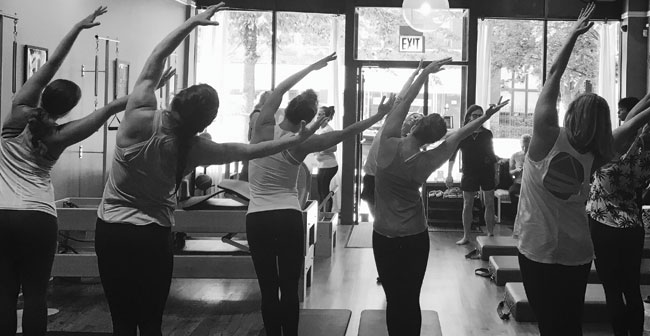
by Kelsey O’Shaughnessy Podgorski
Community is what makes a good job great. Close co-workers can help celebrate achievements and help with tough projects. They serve as a think tank and offer constructive criticism. To encourage stronger workplace communities, more and more companies are changing the way they do business to facilitate teams, make management less hierarchal, strengthen customer connections and even alter the physical space where employees work.
The Right Environment
Giving employees the tools they need to succeed in their position is vital. For a small business, or even just teams looking to branch out of their cubicles, shared workspaces offer flexibility. When looking for a location to grow his Seattle-based design start-up Haystack Studios, owner and founder Mitch Tennison turned to WeWork. This nation-wide company offers shared workspaces for small businesses and start-ups, providing varied options that include spaces that feel more like an outdoor cafe than an office.
Tennison explains that companies can choose the style of office that works best for their needs. Those looking for interaction can select a “hot desk,” or a single desk space shared by many different companies. The “hot desk” puts people in direct contact with other start-up savvy business people.
Though each location houses several companies, WeWork strives to create a cohesive community. Members connect to each other online through a shared digital calendar and a highly collaborative work app that mimics a social media platform. This app offers ways to get in touch and develop working relationships with other tenants in WeWork buildings. But when it comes to building a network, Tennison suggests doing it outside of technology. “I just wander the hallways and introduce myself,” he says, adding that bringing his pup, Bella, has also served as a great ice-breaker.
“From the ground up, the space does everything it can to put people in contact with one another,” says Tennison. But people still need to be proactive. “Naturally, you’re putting yourself out there. I went in knowing I wanted to grow my network and meet other creatives, and that is what I walked away with,” he says.
The Right Team
When Mindvalley, a progressive digital education company, was first setting up its headquarters in Kuala Lumpur, Malaysia, the business was fighting the “brain drain” of an astonishing one percent of the population leaving each year to find work in the “developed world.” Since the country was losing so much of its top talent, Mindvalley founder Vishen Lakhiani had to create a new method of recruitment to keep people from leaving.
To find the right team and create a successful business, Lakhiani decided to create what he calls the “World’s Greatest Workplace.” To achieve this goal, the company constantly works to promote employee “happiness, a noble mission, quests, personal growth and tribal dynamics,” Lakhiani said in a TEDx Talk at TEDxAjman. Mindvalley now draws a diverse group of job candidates from around the world. With such diversity comes a unique tribe of workers who foster a community of growth and development.
Because of Lakhiani’s dedication to creating the “World’s Greatest Workplace,” his team developed a democratic style of management in which employees drive projects and lead their own independent work. The WorldBlu List of Freedom-Centered Workplaces recognized Mindvalley in 2015.
The Right Management
In a traditional corporate structure, if an employee has an innovative idea, he asks his boss. If the boss likes the idea, she might ask the next boss on the food chain and so on. It can take weeks to get approval or a rejection. To fight the slow trickle up the managerial ladder, companies are looking for ways to empower their employees to take ownership of projects.
Punchkick Interactive, a Chicago-based mobile app and site development business, features a horizontal model of self-managed teams, entrusting employees to “get it done” on their own terms. Punchkick hosts a short, daily meeting to celebrate achievements and ask questions, ensuring the team works as a unified body and an active community.
The Right Customer Connections
Fitness apparel powerhouse lululemon athletica has worked to develop a strong community among employees and customers since its inception. To achieve that goal, employees are encouraged to sample local fitness classes to learn how to best serve local clientele.
“If someone comes in and says they’ve never tried yoga, a team member can recommend a local class for beginners,” explains Brooke Johnson, lululemon’s mid-Atlantic area director. “Or, if a client is just beginning to train for their first 5K, employees can recommend the right products at the right level and a great running group.”
With these simple acts, lululemon’s staff forges a connection between the customer, who may be new to the fitness scene, and a local tribe of health-oriented people. The employees go beyond typical sales tactics to get to know each customer and their specific needs. And because of their first-hand knowledge of fitness culture in their community, staff are able to provide personal, hyper-local advice that’s just right for the client.
When it comes to finding spokespeople, lululemon finds the best way to engage the community is to show members of the community doing what they do best. “It’s not about seeing a famous athlete,” says Johnson. “It’s about seeing your local yoga teacher or juice bar owner. It’s about finding out what each community needs and creating an experience that fills that need.”
Kelsey O’Shaughnessy Podgorski writes, edits and generally slays her way through the event industry. She enjoys snuggling her kittens and binge-watching bad TV with her husband.






















No Responses to “Community Works!”